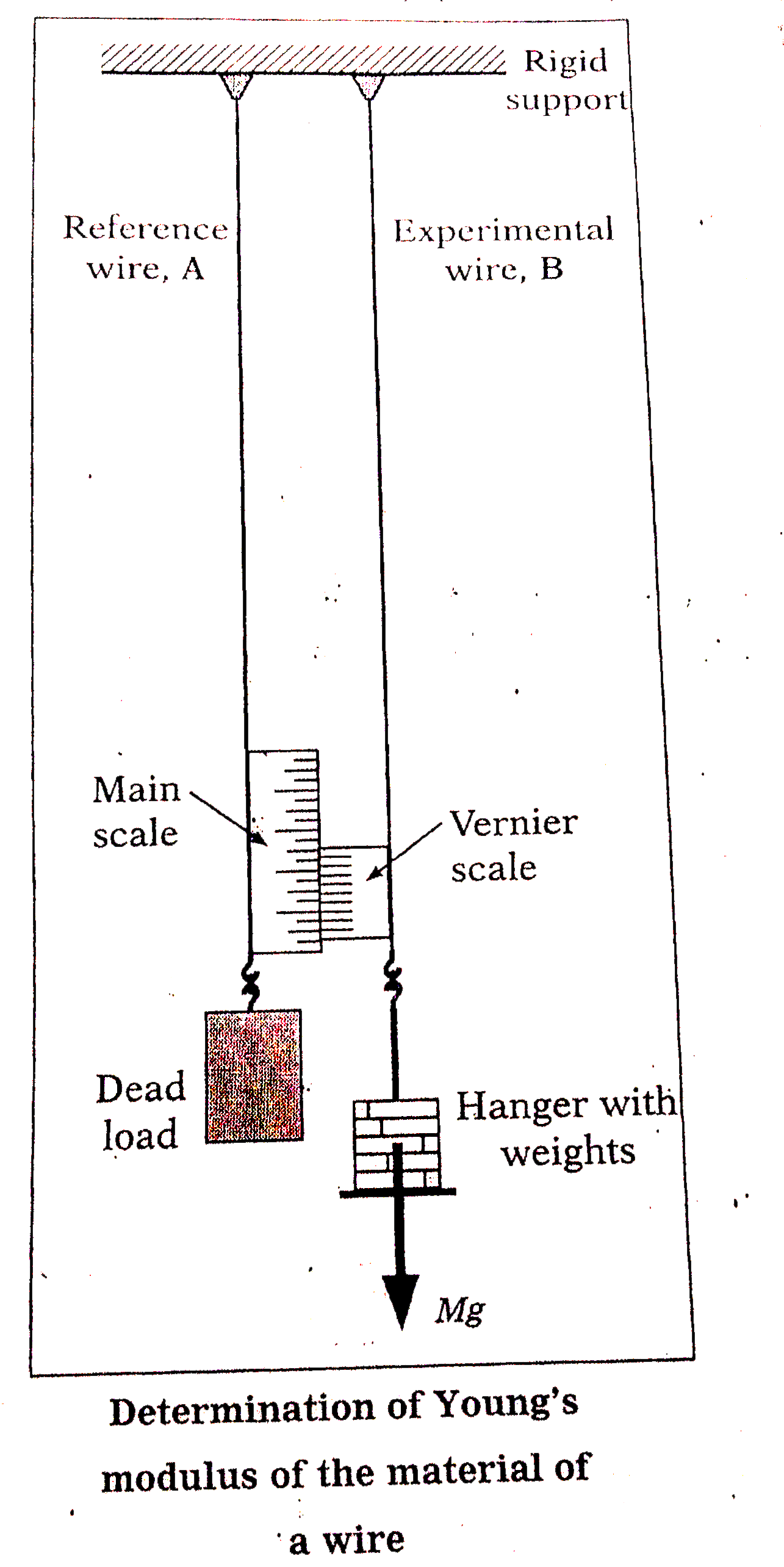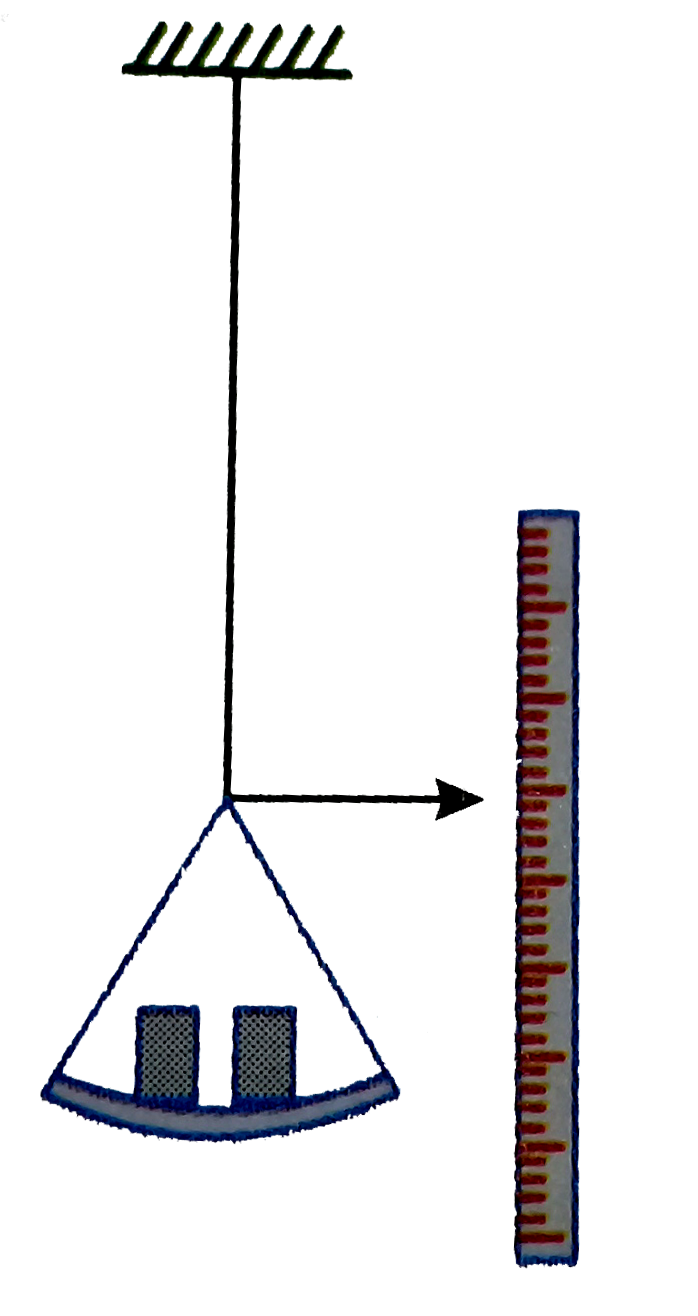Describe a method to determine Young's modulus of the material of a thin wire.
Apparatus : The experimental wire B is suspended from a rigid wallsupport along with a compensating or reference wire A of the same length, material and cross section.
A manin scale is attached to the wire A. Avernier scale attached to the wire B can move alongside the main scale.
A dead load is attached to the compensating wire to keep it taut. Slotted weights may be added to a hanger attached to the experimental wire.

Procedure:
(1) The length L and radius r of the experimental wire are measured.
(2) The experimental wire is initially loaded with 1 kg to 2 kg to keep it taut and free from kinks. It is treated as a zeroload. The main scale and Vernier scale readings are noted as those for zero-load.
(3) The stretching load Mg on the experimental wire is increased by 0.5 kg at a time. the scale readings are noted for each increase in load, after allowing sufficient time for the wire to elongate.
(4) After 6-8 such readings, the wire is unloaded 0.5 kg at a time, and the corresponding scale readings are noted. Within limits of experimental error, the readings for the same load-while loading and unloading- should be the same.
(5) The average elongation per unit mass, is found.
(6) Young's modulus of the material of the wire is calculated using the formula
Topper's Solved these Questions
- EXPERIMENTS AND DIAGRAMSBOOK - NAVNEET PUBLICATION - MAHARASHTRA BOARDCHAPTER - EXPERIMENTS AND DIAGRAMSEXERCISE - WAVE MOTION
1 Videos
- EXPERIMENTS AND DIAGRAMSBOOK - NAVNEET PUBLICATION - MAHARASHTRA BOARDCHAPTER - EXPERIMENTS AND DIAGRAMSEXERCISE - INTERFERENCE AND DIFFRACTION
1 Videos
- DISTINGUISH BETWEENBOOK - NAVNEET PUBLICATION - MAHARASHTRA BOARDCHAPTER - DISTINGUISH BETWEENEXERCISE - Assingment
3 Videos
- EXPLANATION, CHARACTERISTICS AND PROPERTIES BOOK - NAVNEET PUBLICATION - MAHARASHTRA BOARDCHAPTER - EXPLANATION, CHARACTERISTICS AND PROPERTIES EXERCISE - Assignments
2 Videos
Similar Questions
Knowledge Check
To determine Young's modulus of the material of a wire,
Atwo wires of same length and radius are takenBSingle straight wire of uniform cross section is takenCthree wires of different lengths but of same material are takenDtwo springs of same length but different materials are takenWhich of the following apparatus is used to determine the Young's modulus of the material of a gives given wires?
ASearleBsonometerCMetre bridgeDResonance tubeWhich of the following apparatus is used to determine the Young's modulus of the material of a gives given wires?
ASearleBsonometerCMetre bridgeDResonance tube
In an experiment to determine the Young's modulus of the material of a wire, the length of the wire and the suspended mass are doubled. Then the Young's modulus of the wire
View SolutionIn the experiment to determine Young's modulus of the material of a wire under tension
used in the arrangement as shown. The percentage error in the measurement
of length is a in the measurement of the radius of the wire is b and in the
measurement of the change in length of the wire is c. Percentage error in the measurement
of Young's modulus for a given load is

View SolutionIn the experiment to determine Young's modulus of the material of a wire under tension used in the arrangement as shown. The percentage error in the measurement of length is a in the measurement of the radius of the wire is b and in the measurement of the change in length of the wire is c. Percentage error in the measurement of Young's modulus for a given load is

View SolutionThe Young's modulus of the material of a wire is equal ot the
View SolutionThe mass and length of a wire are M and L respectively. The density of the material of the wire is d. On applying the force F on the wire, the increase in length is l, then the Young's modulus of the material of the wire will be
View Solution
